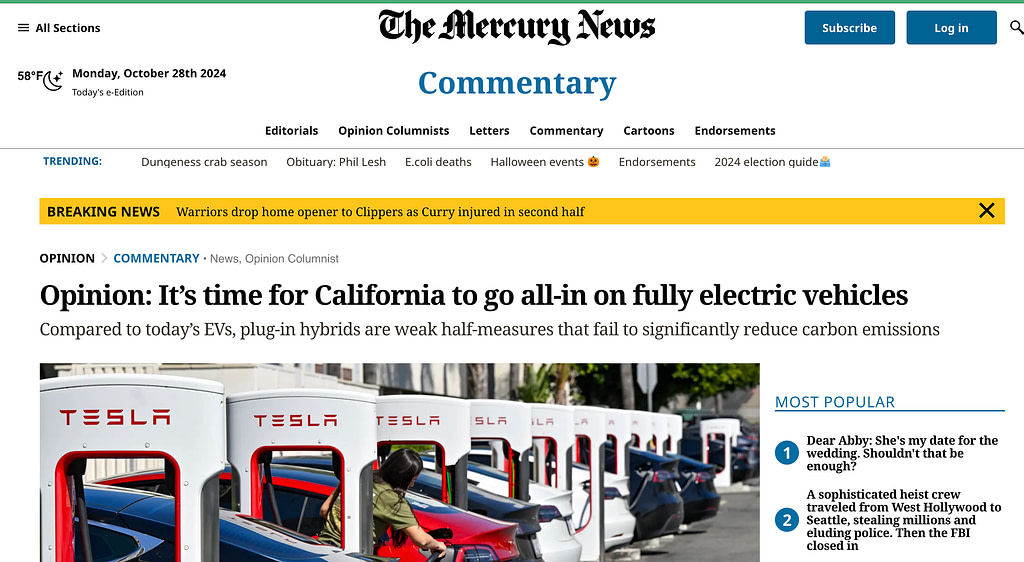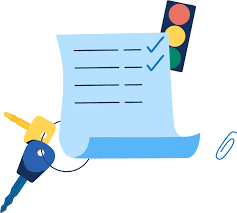
/https://www.mercurynews.com/2024/10/15/opinion-california-go-fully-electric-vehicles/
(paraphrased version here)
Californians want to cut down on the emissions that drive climate change and save money on gas. They hear that plug-in hybrids offer the environmental benefits of an electric car with the convenience of a gasoline vehicle. It’s time to stop the half-measures and go all-in on the only option that will make a meaningful dent in carbon emissions, the full electric vehicle.
Everything else is greenwashing. Hybrids that use gas are a drop in the fuel bucket. They barely achieve the federally mandated goals for fuel efficiency. Plug-in hybrid vehicles are more deceptive. They have one cord that goes into the wall-socket and a longer one that connects to the gas pump.
Most plug-in hybrids travel only 35 to 45 miles on a full battery charge. Even worse, many drivers never plug-in at all 1. These vehicles save about one gallon of gasoline per fill-up. In stark contrast, recent EVs have surpassed the 300-mile range, offsetting 8.5 gallons of fuel. Gas consumption matters. Each gallon of exhaust produces 20 pounds of carbon dioxide that stays in the atmosphere for centuries 2.
Carbon warms our planet and drives the climate change we are experiencing. Our reliance on fossil fuels also brings personal hazards. Studies find that children living adjacent to gas stations have a greater risk of developing leukemia 3. The American Lung Association recently decreed that “a nationwide shift to zero-emission technologies, like electric cars and trucks, will bring major public health benefits through cleaner air and reduced climate pollution” 4.
Drivers want to do the right thing, but fear that EVs won’t go the distance. So, they lean into plug-in hybrids. A few years back that was understandable. The fastest electric vehicle chargers got a black-eye in the public eye because stations were hard-to-locate and about 80% reliable 5. Government officials reacted so new funding opportunities, like the Inflation Reduction Act, require a 97% reliability score. A recent JD Power survey showed customer satisfaction with public fast charging has increased .6
Until now, the lack of fast (Level 3) charging stations steered customers towards Tesla vehicles because of their nationwide network. Tesla has now opened this network to Ford, Rivian, and GM drivers,7 and promises others. The government is addressing charging deserts with its $5 billion, multi-year National Electric Vehicle Infrastructure (NEVI) program. NEVI plans a vast charging backbone at 50-mile intervals across the country’s 48,890 interstate miles. There are currently 69 NEVI-funded charging ports in 17 stations in eight states. Short term, NEVI anticipates conditional agreements for 700 more charging station locations. 8 and 9
Meanwhile, plug- in hybrids are a technology-killer. They deter the entrepreneurship now gaining scale in battery recycling, solid state chemistry, and bidirectional capacity. Bidirectional charging provides additional resiliency during climate change. EV batteries feed energy to homes during power outages and reduce the strain on the electricity grid during peak demand.
Car manufacturers, the oil companies, and the auto-service industry support plug-in hybrids
because they are compatible with their existing business model. But half-way solutions are not the answer when it comes to climate change and the environment. Yes, we can reduce a minimal amount of pollution and environmental destruction with plug-in hybrids. But that’s a frightening scenario for the health of the planet and our human wellbeing.
Electric vehicles provide a better driving experience, are cheaper to fuel and maintain, and prices have dropped dramatically. Affordable 2024 models provide over 300 miles of range and charge in twenty minutes 10. Plug-in hybrids will not produce the change needed to maintain our quality of life. Sometimes it’s necessary to pull the plug on transitional methods and advance to the future.
References Cited: (please contact authors)

A Framework for Digital Training: Provisional Licenses
What’s the path for teens and preteens once the Congressional hearings on social media wrap up? Ideas are likely to come from the transportation field. There will be talk about using guardrails to keep social media in its place and slow down users. And then there will be a push towards civic education and instruction.
So, a provisional digital license/phone may sound suitable and it is something I have campaigned for over a number of years. Before we let kids go online, they need to be fortified with targeted classroom instruction, parental guidance, and real-time experience- just like in driver’s education. Earning a phone is not automatic– kids commit to doing the homework and completing challenges before they are safe on their own.
As in motoring, it takes a decade or longer after a technology emerges for the instructional need to be recognized. It was not until 1932 that drivers education classes were taught in the U.S. For digital education, it has taken nearly 12 years after the initial iPhone for digital education to get mandated.
Curriculums:
Today, just four states have a mandate for this: Texas, Delaware, New Jersey and California. In principle, California has begun the framework for a provisional license. It requires the state’s Instructional Quality Commission to slowly roll out a curriculum framework while considering how to incorporate media literacy content into English language arts, math, science, history and social science lessons.
But, if we are going to have an effective program in digital education, we might want to borrow some more ideas from driver’s education.
In the following table, I compare the two programs on some basics:
| Driver’s Education | Digital California |
|---|---|
| Roughly 10th grade- Ages 14, 15, onward | K-12 |
| Requires direct parental involvement | Primarily Teachers in Schools |
| Practice: inside the car, hands on | Practice: throughout the curriculum |
| Special Problems: DUI, drugs, speeding | Special Problems: Sexting, bullying, privacy |
| Safety: Car Seats, Seat Belts, Air Bags | Safety: COPPA (13 and under) |
continue reading…..https://bemobilesmart.com/drivers-training-digital-literacy-provisional-licenses/

ABOUT JANE GOULD, PhD
I started the DearSmartphone column in 2018. It is a traditional advice column with a modern twist. Readers discuss digital issues and the problems they present.
Be Mobile Smart continues in the DearSmartphone tradition. It drills down on the unique ways that our mobile devices channel our behaviors and collective intelligence. Be Mobile Smart is my personal calling as I have been a researcher in both the transportation field and communications. Feel free to read more about me.
